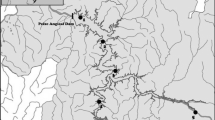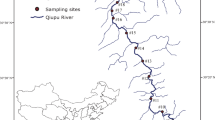Abstract
Large dams disrupt river ecosystems, causing negative effects on fish assemblages. Few studies, however, have investigated how Neotropical fish diversity responds to river regulation in longer temporal scales. In this study, we used a multi-metric approach to investigated temporal changes in taxonomic and functional fish diversity over 15 years-period following the construction of a large dam in the Upper Tocantins River, Amazon. We analyzed biological and environmental data collected in the impounded area before (2000–2002) and after (2003–2014) river regulation. Diversity metrics responded differently to the impoundment. Some metrics were not affected, as they showed little variation over years, such as fish abundance, species, and trait richness. Other metrics changed significantly between periods, such as taxonomic composition, temporal beta diversity, and trait abundance. Species with traits that are sensitive to hydrological alterations declined in the impoundment, while sedentary species were favored. Assemblage trajectories were variable, but community structure developed into a different state in the impoundment. Landscape variables explained changes in fish dissimilarity over time. In general, our study supports the notion that fish diversity in Amazonian rivers is vulnerable to river damming, but also indicates that different metrics show particular responses to this disturbance.




Similar content being viewed by others
References
Agostinho AA, Gomes LC, Pelicice FM (2007) Ecologia e manejo de recursos pesqueiros em reservatórios do Brasil UEM:501p
Agostinho AA, Gomes LC, Santos NC, Ortega JC, Pelicice FM (2016) Fish assemblages in Neotropical reservoirs: colonization patterns, impacts and management. Fish Res 173:26–36
Agostinho AA, Pelicice FM, Gomes LC (2008) Dams and the fish fauna of the Neotropical region: impacts and management related to diversity and fisheries. Braz J Biol 68(4):1119–1132
Agostinho CS, Pelicice FM, Marques EE (2009) Reservatório de peixe angical: bases ecológicas para o manejo da ictiofauna. RiMa, São Carlos 188p
Arantes CC, Fitzgerald DB, Hoeinghaus DJ, Winemiller KO (2019) Impacts of hydroelectric dams on fishes and fisheries in tropical rivers through the lens of functional traits. Curr Opin Environ Sustain 37:28–40
Araújo ES, Marques EE, Freitas IS, Neuberger AL, Fernandes R, Pelicice FM (2013) Changes in distance decay relationships after river regulation: similarity among fish assemblages in a large Amazonian river. Ecol Freshw Fish 22(4):543–552
Barbosa FAR, Padisák J, Espíndola ELG, Borics G, Rocha O (1999) The cascading reservoir continuum concept (CRCC) and its application to the river Tietê-basin, São Paulo State, Brazil 425-439p
Baxter RM (1977) Environmental effects of dams and impoundments. Annu Rev Ecol Syst 8(1):255–283
Borcard D et al. (2018) Numerical ecology with R. Springer. https://doi.org/10.1007/978-1-4419-7976-6
Brasil, Ministério de Minas e Energia (2015) Plano Decenal de Expansão de Energia 2024. Empresa de Pesquisa Energética. Brasília: MME/EPE. 467p
Cardoso P, Rigal F, Carvalho JC (2015) BAT–biodiversity assessment tools, an R package for the measurement and estimation of alpha and beta taxon, phylogenetic and functional diversity. Methods Ecol Evol 6(2):232–236
Chambers JM (1992) Linear models. In: Chambers JM, Hastie TJ (eds) Wadsworth & Brooks/Cole
DeAngelis DL, Waterhouse JC, Post WM, O'Neill RV (1985) Ecological modelling and disturbance evaluation. Ecol Model 29(1–4):399–419
Garnier E, Cortez J, Billès G, Navas ML, Roumet C, Debussche M, Neill C (2004) Plant functional markers capture ecosystem properties during secondary succession. Ecology 85(9):2630–2637
Helfman G, Collette BB, Facey DE, Bowen BW (2009) The diversity of fishes: biology, evolution, and ecology. John Wiley & Sons. 737p
Hoeinghaus DJ, Agostinho AA, Gomes LC, Pelicice FM, Okada EK, Latini JD et al (2009) Effects of river impoundment on ecosystem services of large tropical rivers: embodied energy and market value of artisanal fisheries. Conserv Biol 23(5):1222–1231
Laliberté E, Legendre P (2010) A distance-based framework for measuring functional diversity from multiple traits. Ecology 91(1):299–305
Legendre P, Anderson MJ (1999) Distance-based redundancy analysis: testing multispecies responses in multifactorial ecological experiments. Ecol Monogr 69(1):1–24
Lima AC, Agostinho CS, Sayanda D, Pelicice FM, Soares AM, Monaghan KA (2015) The rise and fall of fish diversity in a neotropical river after impoundment. Hydrobiologia 763(1):207–221
Lima AC, Sayanda D, Agostinho CS, Machado AL, Soares AM, Monaghan KA (2018) Using a trait-based approach to measure the impact of dam closure in fish communities of a Neotropical River. Ecol Freshw Fish 27(1):408–420
Loures RC, Pompeu PS (2018) Long-term study of reservoir cascade in South-Eastern Brazil reveals spatio-temporal gradient in fish assemblages. Mar Freshw Res 69(12):1983–1994
MapBiomas P (2019) Coleção 4 da Série Anual de Mapas de Cobertura e Uso de Solo do Brasil. Available from: https://www.mapbiomas. org. Accessed 6 July 2019
Matthews WJ, Marsh-Matthews E, Cashner RC, Gelwick F (2013) Disturbance and trajectory of change in a stream fish community over four decades. Oecologia 173(3):955–969
Mazzoni R, Petito J (2012) Distribuição, Abundância e estrutura das populações de peixes antes e depois do represamento in Usina Hidrelétrica de Serra da Mesa: 15 anos de estudos da ictiofauna do Alto Tocantins. Rio de Janeiro: Furnas. 139–167
Miller JK, Farr SD (1971) Bimultivariate redundancy: a comprehensive measure of interbattery relationship. Multivar Behav Res 6(3):313–324
Mol JH, Mérona BD, Ouboter PE, Sahdew S (2007) The fish fauna of Brokopondo reservoir, Suriname, during 40 years of impoundment. Neotropical Ichthyol 5(3):351–368
Monaghan KA, Agostinho CS, Pelicice FM, Soares AM (2019) The impact of a hydroelectric dam on Neotropical fish communities: a spatio-temporal analysis of the trophic upsurge hypothesis. Ecol Freshw Fish
Nelson JS, Grande TC, Wilson MV (2016) Fishes of the world. John Wiley & Sons, p 756
Oksanen J, Blanchet FG, Friendly M, Kindt R, Legendre P, McGlinn D et al (2016) Vegan: community ecology package. R Package Version 2:4–1
Orsi ML, Britton JR (2014) Long-term changes in the fish assemblage of a neotropical hydroelectric reservoir. J Fish Biol 84(6):1964–1970
Pelicice FM, Azevedo-Santos VM, Esguícero ALH, Agostinho AA, Arcifa MS (2018) Fish diversity in the cascade of reservoirs along the Paranapanema River, Southeast Brazil. Neotropical Ichthyology 16(2)
Pelicice FM, Azevedo-Santos VM, Vitule JR, Orsi ML, Lima Junior DP, Magalhães AL et al (2017) Neotropical freshwater fishes imperilled by unsustainable policies. Fish Fish 18(6):1119–1133
Pelicice FM, Pompeu PS, Agostinho AA (2015) Large reservoirs as ecological barriers to downstream movements of Neotropical migratory fish. Fish Fish 16(4):697–715
Pereira HR, Gomes LF, Oliveira Barbosa H, Pelicice FM, Nabout JC, Teresa FB, Vieira LCG (2020) Research on dams and fishes: determinants, directions, and gaps in the world scientific production. Hydrobiologia 847(2):579–592
Perônico PB, Agostinho CS, Fernandes R, Pelicice FM (2020) Community reassembly after river regulation: rapid loss of fish diversity and the emergence of a new state. Hydrobiologia 847(2):519–533
Philippsen JS, Minte-Vera CV, Coll M, Angelini R (2019) Assessing fishing impacts in a tropical reservoir through an ecosystem modeling approach. Rev Fish Biol Fish 29(1):125–146
Podani J, Schmera D (2011) A new conceptual and methodological framework for exploring and explaining pattern in presence–absence data. Oikos 120(11):1625–1638
Podani J, Ricotta C, Schmera D (2013) A general framework for analyzing beta diversity, nestedness and related community-level phenomena based on abundance data. Ecol Complex 15:52–61
Poff NL, Allan JD, Bain MB, Karr JR, Prestegaard KL, Richter BD et al (1997) The natural flow regime. BioScience 47(11):769–784
Poff NL, Zimmerman JK (2010) Ecological responses to altered flow regimes: a literature review to inform the science and management of environmental flows. Freshw Biol 55(1):194–205
Pompeu PDS, Agostinho AA, Pelicice FM (2012) Existing and future challenges: the concept of successful fish passage in South America. River Res Appl 28(4):504–512
Pringle CM, Freeman MC, Freeman BJ (2000) Regional effects of hydrologic alterations on riverine macrobiota in the new world: tropical-temperate comparisons: the massive scope of large dams and other hydrologic modifications in the temperate New World has resulted in distinct regional trends of biotic impoverishment. While neotropical rivers have fewer dams and limited data upon which to make regional generalizations, they are ecologically vulnerable to increasing hydropower development and biotic patterns are emerging. BioScience 50(9):807–823
R Development Core Team. 2019. A language and environment for statistical computing. R Foundation for Statistical Computing, Vienna. Available from: http://www.R-project.org. Accessed 8 December 2019
Ribeiro MCLDB, Petrere M, Juras AA (1995) Ecological integrity and fisheries ecology of the Araguaia—Tocantins River basin, Brazil. Regul Rivers: Res Manag 11(3–4):325–350
Santos GM, Mérona BD, Juras AA, Jégu M (2004) Peixes do Baixo Rio Tocantins: 20 anos depois da usina hidrelétrica Tucurui. In: Eletrobras, 2s16p
Santos NCL et al (2017) Environmental filters predict the trait composition of fish communities in reservoir cascades. Hydrobiologia 802(1):245–253
Tilt B, Braun Y, He D (2009) Social impacts of large dam projects: a comparison of international case studies and implications for best practice. J Environ Manag 90:S249–S257
Toussaint A, Charpin N, Brosse S, Villéger, S (2016) Global functional diversity of freshwater fish is concentrated in the Neotropics while functional vulnerability is widespread Scientific Reports, 6
Tractabel-Energia. 2017. Relatório de Monitoramento da UHE Cana Brava. Available from:http://licenciamento.ibama.gov.br/Hidreletricas/Cana%20Brava/Relatorio%20Monitoramento. Accessed 1 July 2019
Turgeon K, Solomon CT, Nozais C, Gregory-Eaves I (2016) Do novel ecosystems follow predictable trajectories? Testing the trophic surge hypothesis in reservoirs using fish. Ecosphere 7(12):e01617
Turgeon K, Turpin C, Gregory-Eaves I (2019) Boreal river impoundments caused nearshore fish community assemblage shifts but little change in diversity: a multiscale analysis. Can J Fish Aquat Sci 76(5):740–752
Vanni MJ, Arend KK, Bremigan MT, Bunnell DB, Garvey JE, Gonzalez MJ et al (2005) Linking landscapes and food webs: effects of omnivorous fish and watersheds on reservoir ecosystems. BioScience 55(2):155–167
Vanni MJ, Bowling AM, Dickman EM, Hale RS, Higgins KA, Horgan MJ et al (2006) Nutrient cycling by fish supports relatively more primary production as lake productivity increases. Ecology 87(7):1696–1709
Villéger S, Mason NW, Mouillot D (2008) New multidimensional functional diversity indices for a multifaceted framework in functional ecology. Ecology 89(8):2290–2301
Winemiller KO, Fitzgerald DB, Bower LM, Pianka ER (2015) Functional traits, convergent evolution, and periodic tables of niches. Ecol Lett 18(8):737–751
Winemiller KO, McIntyre PB, Castello L, Fluet-Chouinard E, Giarrizzo T, Nam S et al (2016) Balancing hydropower and biodiversity in the Amazon, Congo, and Mekong. Science 351(6269):128–121
Zuur AEN, Ieno GM (2007) Analyzing ecological data. Springer, New York 672
Acknowledgments
Thank you for all the suggestions made by the professors from the Programa de Pós Graduação em Ciências Ambientais-PPGCA of Universidade de Brasília-UnB. This work was supported by the Coordenação de Aperfeiçoamento de Pessoal de Nível Superior CAPES (Financing Code 001), a Brazilian public institution for the promotion of research. FBT, FMP and LCGV were supported by productivity fellowships of Conselho Nacional de Desenvolvimento Científico e Tecnológico (CNPq)
Author information
Authors and Affiliations
Corresponding author
Additional information
Publisher’s note
Springer Nature remains neutral with regard to jurisdictional claims in published maps and institutional affiliations.
Supplementary Information
ESM 1
(DOCX 114 kb)
Rights and permissions
About this article
Cite this article
Pereira, H.R., Gomes, L.F., Soares, P.T. et al. Long-term responses of fish diversity to river regulation: a multi-metric approach. Environ Biol Fish 104, 71–84 (2021). https://doi.org/10.1007/s10641-021-01056-0
Received:
Accepted:
Published:
Issue Date:
DOI: https://doi.org/10.1007/s10641-021-01056-0




